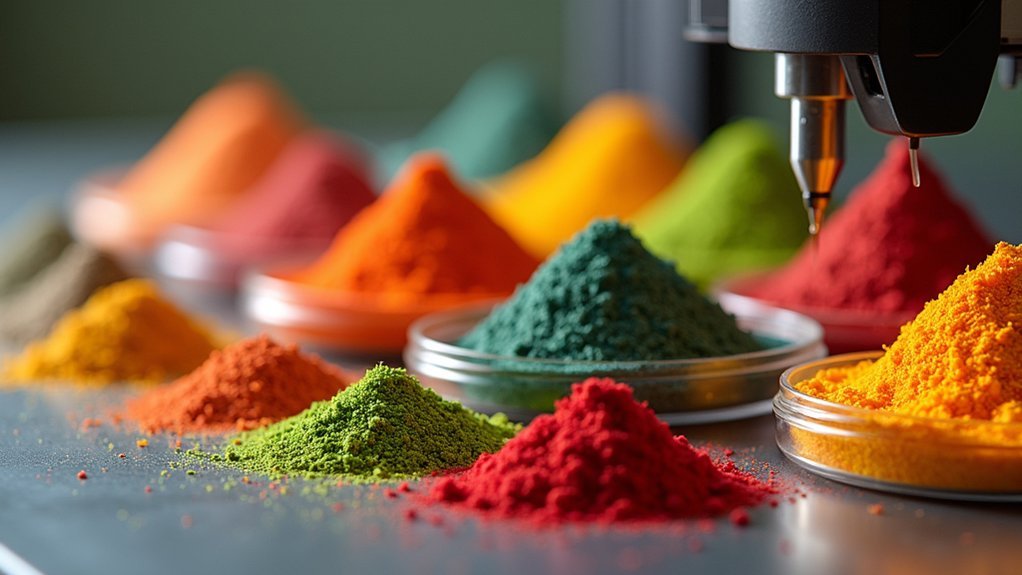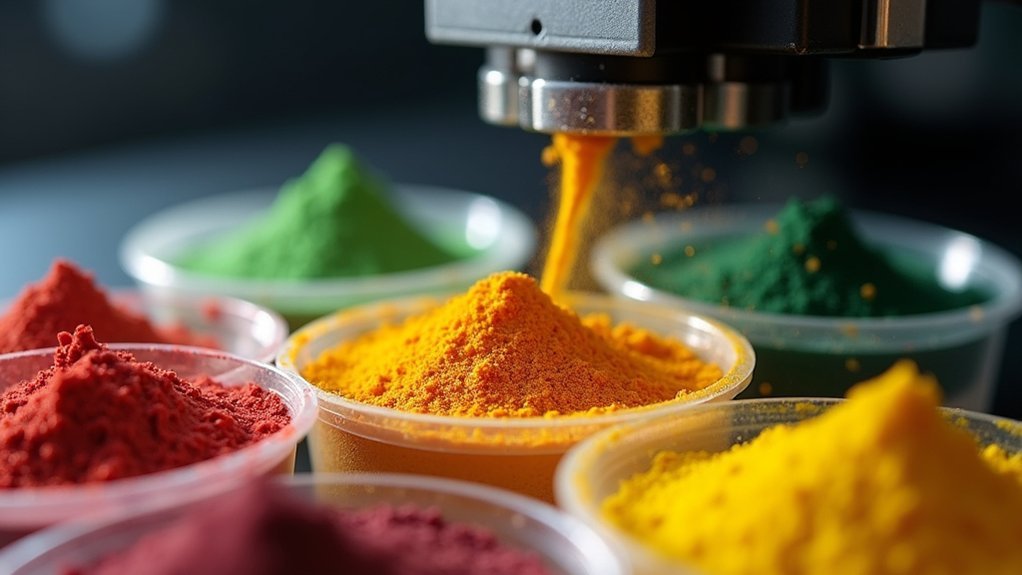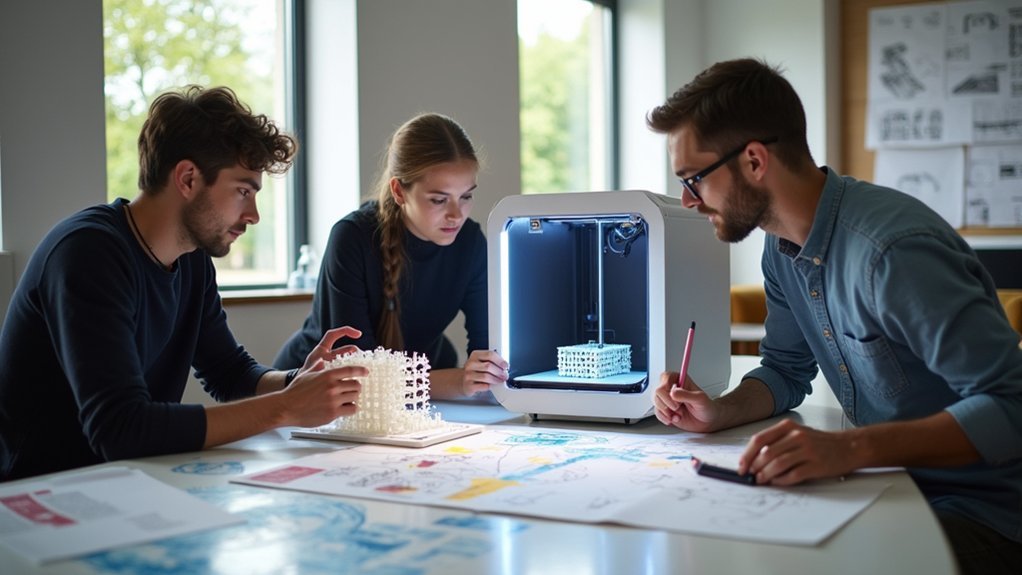You’ll find freeze-dried powders revolutionize edible 3D printing by retaining up to 90% of original nutrients while creating stable, printable food inks. They’re lightweight, shelf-stable for 24 months, and enhance bioavailability of essential compounds. The ideal concentration is 5g, which provides superior printability without compromising structural integrity or taste. These powders offer excellent water retention, moderate viscosity, and shear-thinning behavior essential for smooth extrusion. Discover how this technology transforms fresh ingredients into precise, nutritious printed foods.
Understanding Freeze-Dried Powder Technology in Food Applications

Freeze-dried powder technology transforms fresh food into lightweight, shelf-stable ingredients through a precise two-stage process that preserves both nutrition and flavor.
You’ll find this method involves freezing your food products first, then reducing surrounding pressure to allow water sublimation directly from ice to vapor, completely bypassing the liquid phase. This sublimation process removes moisture while maintaining the food’s original nutritional content and extending shelf life considerably.
When you’re working with 3D food printing, these freeze-dried powders become invaluable primary ingredients. They create stable, printable food inks with excellent rheological properties that guarantee consistent extrusion.
You’ll discover that incorporating freeze-dried fruit powders into your composite gels dramatically improves water binding capacity, resulting in enhanced texture and superior print quality for your edible creations.
Nutritional Benefits of Freeze-Dried Fruit and Vegetable Powders
When you freeze-dry fruits and vegetables into powders, you’ll preserve most of their original vitamins, minerals, and antioxidants that would otherwise degrade through conventional drying methods.
You’re actually concentrating these nutrients since the water’s removed while leaving the beneficial compounds intact, creating a more potent nutritional profile per gram.
You’ll also find that your body can absorb these nutrients more efficiently because the freeze-drying process breaks down cellular structures, making vitamins and minerals more accessible during digestion.
Nutrient Retention During Processing
Since traditional drying methods often destroy valuable vitamins and minerals, you’ll find that freeze-drying stands out as a superior preservation technique that retains up to 90% of the original nutrients in fruits and vegetables.
This process removes moisture while preserving cellular structure, maintaining flavor, color, and nutritional quality. When you incorporate freeze-dried vegetable powders into your 3D printing formulations, you’re creating nutrient-rich foods without sacrificing essential vitamins and antioxidants.
The freeze-drying process guarantees exceptional nutrient retention by avoiding high temperatures that typically degrade sensitive compounds.
You can rehydrate these powders to restore much of their original nutritional content, making them perfect for 3D printing applications. This preservation method allows you to enhance dietary fiber and antioxidant content while maintaining the structural integrity needed for successful printing.
Enhanced Bioavailability Properties
Beyond simple nutrient preservation, you’ll discover that freeze-dried fruit and vegetable powders actually enhance the bioavailability of essential compounds when incorporated into 3D-printed foods.
The freeze-drying process preserves bioactive compounds while making them more accessible to your digestive system. When you use these freeze-dried powders in 3D printing applications, you’re creating foods with superior nutritional profiles compared to traditional processing methods.
These enhanced bioavailability properties mean your body can absorb vitamins, minerals, and antioxidants more efficiently.
The concentrated nature of freeze-dried powders delivers maximum nutritional impact in smaller portions. This becomes particularly valuable when you’re designing foods for specific dietary needs or therapeutic applications through 3D printing technology, ensuring ideal nutrient delivery.
Rheological Properties Essential for 3D Food Printing Success

When you’re formulating edible inks with freeze-dried powders, you’ll need to master two critical rheological parameters: viscosity and yield stress.
Your ink’s viscosity determines how easily it flows through the printer nozzle, while yield stress controls whether the extruded material maintains its shape after printing.
You’ll find that achieving the right balance between these properties directly impacts your printing success and the structural integrity of your final food product.
Viscosity and Flow Behavior
Although 3D food printing offers revolutionary possibilities for customized nutrition, its success hinges entirely on achieving the right rheological properties in your printing materials.
You’ll need moderate viscosity in your food inks to guarantee easy extrusion while maintaining structural integrity after printing. PGP/GE formulations demonstrate this ideal balance perfectly.
Your printing success depends heavily on shear-thinning behavior, which allows materials to flow smoothly during extrusion then stabilize immediately afterward.
When you add fruit powders at low concentrations (5g), you’ll enhance water binding capacity, directly improving your ink’s rheological properties.
The hydrocolloid composition you choose considerably influences this shear-thinning behavior.
Yield Stress Requirements
Your material’s yield stress determines whether your printed food structure will hold its shape or collapse into an unrecognizable mess. You need precise yield stress values to achieve successful 3D printing with freeze-dried powder formulations.
Too low, and your structures sag immediately after extrusion. Too high, and your food inks won’t flow through the nozzle properly.
Through rheological analysis, you’ll identify the best balance between flowability and structural integrity. You can enhance yield stress by incorporating hydrocolloids into your freeze-dried powder mixtures.
These additives create the necessary thixotropic behavior—your ink flows under extrusion pressure but immediately regains strength when pressure stops.
Monitor your formulations carefully. The right yield stress guarantees clean layer adhesion and prevents deformation during the printing process.
Water Binding Capacity and Its Impact on Print Quality
Since water binding capacity directly determines how well your 3D printed foods maintain their shape during and after printing, understanding this property becomes essential for achieving high-quality results.
When you incorporate fruit powders into PGP/GE composite gels, you’ll greatly enhance their water retention capabilities, leading to improved structural integrity.
Research demonstrates that freeze-dried strawberry, yellow peach, and mango powders effectively boost water binding in printing materials. However, you’ll achieve peak print quality with 5g dosages rather than 10g concentrations.
Key benefits include:
- Enhanced rheological properties with improved viscosity and shear-thinning behavior
- Better printability through superior water retention during extrusion
- Maintained structural integrity throughout the printing process
- Improved palatability and sensory characteristics in final products
Optimal Powder Concentrations for Enhanced Printing Performance

When determining the ideal fruit powder concentration for your 3D printing applications, you’ll find that less is definitively more. Research demonstrates that 5g of freeze-dried fruit powders delivers superior printability compared to higher concentrations, which compromise printing performance.
| Concentration | Printing Quality | Sensory Score | Water Binding |
|---|---|---|---|
| 5g | Excellent | High | Best |
| 10g | Poor | Low | Excessive |
| 15g | Failed | Very Low | Poor |
| 20g | Failed | Unacceptable | Poor |
You’ll achieve best concentrations when balancing enhanced viscosity with desirable texture. The 5g threshold maintains moderate viscosity in PGP/GE substrates while preserving sensory qualities. Higher doses create printing difficulties and negatively impact final product acceptance, making precise measurement essential for successful fruit powders integration.
Comparative Analysis of Different Fruit Powder Types
When you’re selecting fruit powders for 3D printing, you’ll find that different types offer varying water binding capacities that directly impact your final product’s quality.
Strawberry, yellow peach, and mango powders each deliver unique printing performance characteristics, with strawberry consistently outperforming others in texture and sensory evaluations.
You’ll need to evaluate how each powder type affects your gel’s rheological properties since this determines whether your prints maintain structural integrity during the printing process.
Water Binding Capacity
Water retention becomes a critical factor when you’re evaluating freeze-dried fruit powders for 3D printing applications. The water binding capacity of your composite gels directly impacts printing performance and final product quality.
Strawberry, yellow peach, and mango powders demonstrate remarkable ability to enhance water retention in PGP/GE systems, fundamentally improving texture modification properties.
Your ideal results occur when using 5 grams of fruit powder rather than higher concentrations. This moderate dosage maintains proper rheological balance while maximizing water binding benefits.
- Enhanced water retention improves gel stability during extrusion processes
- Ideal 5-gram dosage prevents over-thickening that compromises printability
- Strawberry powder shows superior binding compared to other fruit varieties
- Lower concentrations deliver better taste profiles without sacrificing functionality
Printing Quality Performance
Three distinct fruit powders deliver noticeably different printing quality performance in PGP/GE composite gel systems.
When you’re working with 3D food printing applications, you’ll find that yellow peach, strawberry, and mango powders each contribute unique benefits at ideal 5g dosages.
Strawberry powder consistently demonstrates superior performance, enhancing both structural integrity and flavor profiles in your printed products.
The moderate viscosity of PGP/GE gels becomes considerably more manageable when you incorporate these fruit powders, resulting in cleaner layer definition and reduced printing defects.
You’ll notice that higher doses like 10g actually compromise printing quality, while the 5g threshold maintains excellent water binding capacity.
This careful balance guarantees your final products achieve enhanced nutritional appeal without sacrificing the precision required for successful edible manufacturing.
Texture and Sensory
Beyond printing performance metrics, the sensory characteristics of your freeze-dried fruit powder formulations reveal considerable differences that directly impact consumer acceptance.
Your texture analysis demonstrates that 5g fruit powder additions achieve ideal balance between structural integrity and mouthfeel in printed food applications. Lower concentrations consistently outperform higher doses in sensory evaluations, suggesting that excessive powder compromises taste and texture quality.
Key sensory findings include:
- Strawberry, yellow peach, and mango powders enhance water binding capacity while maintaining pleasant texture
- 5g formulations deliver superior overall sensory experience compared to 10g concentrations
- Enhanced aesthetic appeal improves consumer dining experience considerably
- Nutritional value increases without sacrificing sensory qualities
When selecting food additives for 3D printing, you’ll find that moderate fruit powder concentrations optimize both printability and consumer satisfaction.
Peach Gum Polysaccharides as Base Materials for Edible Inks
When you’re developing edible inks for 3D food printing, peach gum polysaccharides (PGP) combined with gellan gum (GE) create an exceptional foundation that delivers both quality and stability.
This substrate combination provides the structural integrity you need for successful layer-by-layer construction while maintaining food-safe properties.
You’ll find that incorporating freeze-dried fruit powders at precisely 5 grams greatly enhances your ink’s performance. The fruit powders improve water binding capacity, which directly translates to better printing outcomes.
Yellow peach, strawberry, and mango powders have proven particularly effective at maximizing rheological properties.
However, you should avoid exceeding the 5-gram threshold. When you increase fruit powder concentrations to 10 grams, printing quality deteriorates noticeably.
The ideal dosage guarantees your edible inks maintain proper flow characteristics while delivering improved functionality for 3D food applications.
Texture Modification Techniques for Dysphagic Patient Applications
Four key texture modification techniques transform standard 3D printed foods into safe, appealing options for dysphagic patients.
You’ll find that printing technology enables precise control over food consistency, ensuring texture-modified foods meet individual swallowing capabilities. These approaches create nutrient-rich and safe alternatives that address traditional palatability concerns.
- Layered density control – You can adjust material density throughout printing to create softer textures that maintain structural integrity.
- Cohesive binding enhancement – Strategic ingredient combinations improve bolus formation for safer swallowing.
- Surface smoothing techniques – Post-printing methods eliminate rough textures that could pose aspiration risks.
- Personalized consistency calibration – Custom formulations match International Dysphagia Diet Standardization Initiative guidelines for individual patient needs.
You’ll discover these techniques greatly improve meal enjoyment while providing dysphagic patients with adequate nutrition and safety.
Sensory Evaluation Methods for 3D Printed Food Products
While texture modification techniques guarantee safety for dysphagic patients, you’ll need thorough sensory evaluation methods to determine whether your 3D printed foods actually deliver satisfying eating experiences.
You can employ trained panels or consumer testing groups to assess essential attributes like taste, texture, aroma, and visual appeal. These evaluations focus on determining overall acceptability and understanding consumer preferences for your products.
Descriptive analysis techniques will help you quantify specific sensory characteristics, particularly when testing different formulations such as varying fruit powder concentrations.
You’ll want to use hedonic scales to measure consumer liking and identify ideal ingredient combinations. For dysphagia applications, texture and flavor assessments become especially vital since you must make certain texture-modified foods remain both palatable and appealing to patients with swallowing difficulties.
Processing Parameters Affecting Final Product Characteristics
Since rheological properties fundamentally determine your 3D printing success, you’ll need to carefully control the viscosity of your freeze-dried powders formulations to achieve proper extrusion and structural integrity.
Your processing parameters directly influence water binding capacity, which affects the final texture and mouthfeel of your printed products.
When incorporating fruit powders into your formulations, you’ll achieve better results with lower doses around 5g rather than higher concentrations. This approach enhances water binding ability while maintaining ideal printability for your 3D printed foods.
Key processing parameters that affect your final product include:
- Particle size distribution of freeze-dried powders
- Moisture content levels during formulation
- Hydrocolloid concentrations for textural modifications
- Fruit powder selection and dosage optimization
These factors collectively determine your product’s success in meeting targeted texture profiles.
Storage and Stability Requirements for Freeze-Dried Powders
After perfecting your processing parameters for ideal 3D printing performance, proper storage becomes your next priority to maintain powder quality and functionality. Your freeze-dried powders require specific conditions to preserve their stability and nutritional properties.
| Storage Factor | Requirement | Purpose |
|---|---|---|
| Container Type | Airtight/Vacuum-sealed | Prevent moisture absorption |
| Temperature | 20°C to 25°C | Maintain structural integrity |
| Environment | Dark, low humidity | Avoid degradation |
| Monitoring | Regular inspection | Detect spoilage signs |
You’ll need to store your powders in airtight containers at prime temperatures while avoiding direct sunlight. Vacuum sealing enhances stability by minimizing oxygen exposure, preventing oxidation that compromises flavor and nutrients. Monitor regularly for color, odor, or texture changes. Proper storage extends shelf life up to 24 months, ensuring your freeze-dried powders maintain their 3D printing performance.
Cost-Effectiveness Analysis of Powder-Based Printing Systems
When evaluating powder-based 3D printing systems, you’ll find that freeze-dried powders deliver considerable cost advantages over traditional food production methods.
These lightweight ingredients reduce transportation expenses while extending shelf life, eliminating frequent restocking costs. You’ll save markedly on labor since freeze-dried powders require minimal processing compared to fresh produce preparation.
Freeze-dried powders slash transportation costs and labor expenses while eliminating the need for frequent restocking of perishable ingredients.
The cost-effectiveness of these systems becomes even more apparent when you consider waste reduction and ingredient optimization:
- Reduced storage costs – Compact powders require less refrigeration and warehouse space
- Lower labor expenses – Minimal preparation time compared to fresh ingredient processing
- Enhanced nutrient retention – Maintains nutritional value while reducing spoilage losses
- Decreased food waste – Precise ingredient usage eliminates overproduction and disposal costs
This combination makes powder-based 3D printing systems increasingly viable for small-scale producers.
Quality Control Standards for Edible 3D Printing Materials
While cost-effectiveness makes freeze-dried powders attractive for 3D printing applications, you must establish rigorous quality control standards to verify your edible printing materials meet safety and performance requirements. Your edible inks require thorough assessment of rheological properties, including viscosity and shear-thinning behavior, to guarantee ideal printability and texture.
| Quality Parameter | Standard Requirement |
|---|---|
| Hydrocolloid Content | ≤2% maximum |
| Rheological Properties | Viscosity 10-50 Pa·s |
| Water Binding Capacity | Fruit powder dependent |
| Nutritional Profile | Complete macro/micronutrients |
You’ll need to limit hydrocolloids to 2% maximum to maintain appealing taste and texture. Regular testing against established guidelines helps mitigate nutritional deficiencies while verifying your printed foods meet dietary needs, particularly for vulnerable populations like dysphagic patients.
Future Developments in Freeze-Dried Food Printing Technology
As freeze-dried food printing technology evolves, you’ll see researchers prioritizing formulation enhancement that increases nutritional density while reducing dependence on hydrocolloids.
Scientists are incorporating fresh vegetables and fruit powders into freeze-dried formulations, creating 3D printed foods with superior texture and flavor profiles.
You’ll witness groundbreaking innovations in 4D printing, where freeze-dried materials respond to stimuli by changing color or releasing aromas during consumption.
Future developments focus on integrating health-promoting additives like probiotics into formulations, greatly boosting nutritional value and digestive benefits.
Through continued collaboration between food scientists and engineers, you’ll experience broader culinary applications as public perception improves and ingredient availability expands.
- Enhanced formulations minimizing hydrocolloid usage while maintaining ideal printability
- Integration of diverse ingredients including fresh vegetables and fruit powders
- 4D printing capabilities with stimuli-responsive color changes and aroma release
- Incorporation of probiotics and other health-promoting additives for enhanced nutrition
Frequently Asked Questions
Can I Turn Freeze-Dried Fruit Into Powder?
You can easily turn freeze-dried fruit into powder by grinding it in a blender or food processor. The process creates fine, flavorful powder that retains the fruit’s nutrients and color.
What Is Freeze-Dried Fruit Powder Used For?
You’ll use freeze-dried fruit powder as natural flavor enhancers, food colorants, smoothie additives, baking ingredients, and nutritional supplements. It’s perfect for extending shelf life while preserving vitamins and creating concentrated fruit flavors.





Leave a Reply